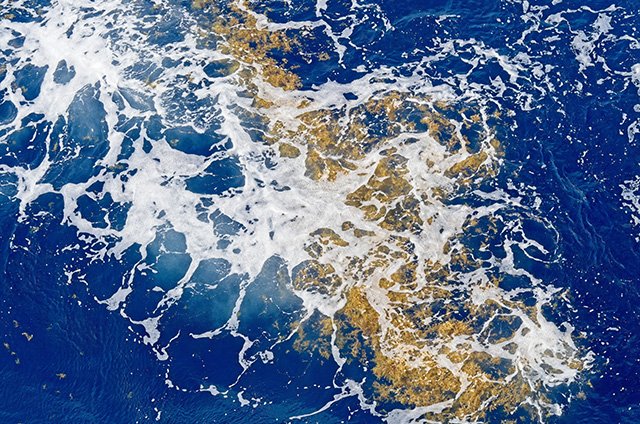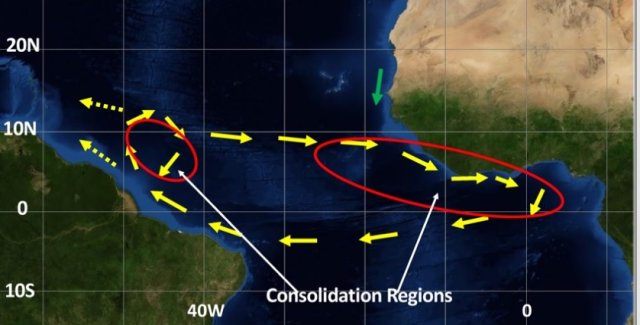Origin and Drivers of the Great Atlantic Sargassum Belt (GASB)
Scientists have used modeling, satellites, and field observations to understand the origins of the GASB, identify the relationship of Sargassum in the GASB to Sargassum in the Sargasso Sea, explore drivers of GASB blooms, predict movement and intensity of Sargassum aggregations in the GASB, and identify impacts of the GASB.
Like many large environmental issues, there are many drivers that are thought to play a role in the GASB. Work is being done to figure out the exact roles that potential drivers play in the size and timing of the GASB. Scientists agree that the GASB is seasonal, is maintained by the availability of a source population of Sargassum in the Atlantic, is sustained by nutrients from deep ocean currents and land-based sources, varies due to changes in temperature and salinity, and is influenced by wind and current circulation. These main drivers interact in many ways to influence the timing and size of the GASB.
On this page:
Nutrients
Nutrients, specifically nitrogen and phosphorus, are important drivers of variability in the biomass and spatial coverage of the GASB. Proposed sources of nitrogen and phosphorus fueling the GASB include: (1) discharges from Congo, Amazon, and Mississippi rivers, (2) upwelling off the coast of Africa, (3) vertical mixing, (4) equatorial upwelling, (5) atmospheric deposition from Saharan dust, (6) the burning of plant biomass in central and southern Africa, and (7) loads from urbanized coastal areas. Several examples from the literature have documented a link between the growth rate and extent of Sargassum aggregations and high nutrient supply from each of these sources. It does not appear that a single source of nutrients along the tropical Atlantic waters fuels the GASB, rather a dominant theory is that various sources of nutrients play local roles in fueling the GASB as it moves west from the eastern Atlantic along the tropics to the western Atlantic, Gulf of America, and Caribbean.

Long-term studies (1983-2019) link tissue concentrations of nitrogen and phosphorus in Sargassum over time to an increased trend in global nitrogen during the same time period. Sargassum is likely exploiting increased nitrogen in nutrient polluted areas, like the Gulf of America, as evidenced by increased nitrogen:phosphorus ratios in Sargassum tissue. In the Gulf, the highest nitrogen values corresponded to coastal waters affected by nutrient pollution in terrestrial runoff and peak river discharges during winter and spring. Findings such as these are providing support for the theory that increased local nitrogen availability is supporting Sargassum blooms at local scales.
Temperature
Sargassum can generally tolerate a wide range of temperatures. A laboratory study examining optimal growing conditions of Sargassum species of the Sargasso Sea, Sargassum natans and Sargassum fluitans, identified a range of 18-30°C or 64.4-86°F as the optimal temperature range for these species. Sargassum likely grows faster in the GASB than in the cooler waters of the Sargasso Sea. However, within the GASB, Sargassum may grow better within areas of cooler temperatures, where nutrient availability may be higher; suggesting nutrients may be the more significant driver of growth than temperature. A recent study evaluating the growth of genotypes of Sargassum at different temperatures within their natural range, indicated similarly high growth rates over the entire temperature range. This result negated a hypothesis that sea surface temperature warming between 2010-2020 was a primary driver of the GASB; rather, nutrients from upwelling and riverine inputs may be playing a more significant role.
Salinity
Several Sargassum species, including Sargassum natans and Sargassum fluitans have exhibited optimal laboratory growth rates at salinities between 36-42 parts per thousand (referred to as practical salinity units (PSU)) and experienced a reduction in growth rates below 30 PSU. Similarly, another study found an even distribution of Sargassum biomass across 32 to 36 PSU and lower biomass below 31 PSU. Sargassum had greater abundance across the salinities ranging from 32.4 to 33.5 PSU than 33.5 to 35 PSU. Greater abundance of Sargassum in the lower salinity range was attributed to riverine influences (with increased freshwater inflow and increased nutrients) across the geography studied.
Wind and Ocean Circulation
A combination of nutrient-rich waters in the tropical north Atlantic and strong convergence of trade winds in the Intertropical Convergence Zone has contributed to the accumulation of Sargassum in this region, forming the GASB. Trade winds of the Northern and Southern Hemispheres come together to generate a zone known as the Intertropical Convergence Zone where Sargassum accumulates as the GASB. Westward ocean currents and trade winds join the North Brazilian Current off the coast of Brazil to push the GASB up the coast where it joins the North Equatorial Counter Current, generating an efficient recirculating pattern in the tropical Atlantic (i.e., North Equatorial Recirculation Region). Winds along with current circulation patterns from two areas off the northwestern coast of Africa and north of Brazil help create and fuel the biomass of the GASB. The relationship of these currents and wind patterns is proposed to help create and maintain the GASB. Perturbations to this circulatory pattern or the nutrient sources along its path result in changes to the annual abundance of Sargassum in the GASB and the amount that escapes to the Caribbean and Gulf of America. Trade winds that transport Saharan dust also act as an additional minor contribution of nutrients to the GASB.

References:
- Brooks, M. T., Coles, V. J., Hood, R. R., & Gower, J. F. (2018). Factors controlling the seasonal distribution of pelagic Sargassum. Marine Ecology Progress Series, 599, 1-18.
- Franks, J. S., Johnson, D. R., & Ko, D. S. (2016). Pelagic Sargassum in the tropical North Atlantic. Gulf and Caribbean Research, 27(1), SC6-SC11.
- Hanisak, M. D., & Samuel, M. A. (1987). Growth rates in culture of several species of Sargassum from Florida, USA. Hydrobiologia, 151-152(1), 399-404.
- Johns, E. M., Lumpkin, R., Putman, N. F., Smith, R. H., Muller-Karger, F. E., Rueda-Roa, D. T., Hu, C., Wang, M., Brooks, M. T., & Gramer, L. J. (2020). The establishment of a pelagic Sargassum population in the tropical Atlantic: Biological consequences of a basin-scale long distance dispersal event. Progress in Oceanography, 182, 102269.
- Lapointe, B., Brewton, R., Herren, L., Wang, M., Hu, C., Mcgillicuddy, D. J., Jr., Lindell, S., Hernandez, F., & Morton, P. (2021). Nutrient content and stoichiometry of pelagic Sargassum reflects increasing nitrogen availability in the Atlantic Basin. Nature Communications, 12, 3060.
- Magaña-Gallegos, E., García-Sánchez, M., Graham, C., Olivos-Ortiz, Siuda, A. N. S., & van Tussenbroek, B. I. (2023). Growth rates of pelagic Sargassum species in the Mexican Caribbean. Aquatic Botany, 185, 103614.
- Skliris, N., Marsh, R., Appeaning Addo, K., & Oxenford, H. (2022). Physical drivers of pelagic Sargassum bloom interannual variability in the Central West Atlantic over 2010–2020. Ocean Dynamics, 72, 383-404.
- Wang, M., Hu, C., Barnes, B. B., Mitchum, G., Lapointe, B., & Montoya, J. P. (2019). The great Atlantic Sargassum belt. Science, 365, 83-87.
